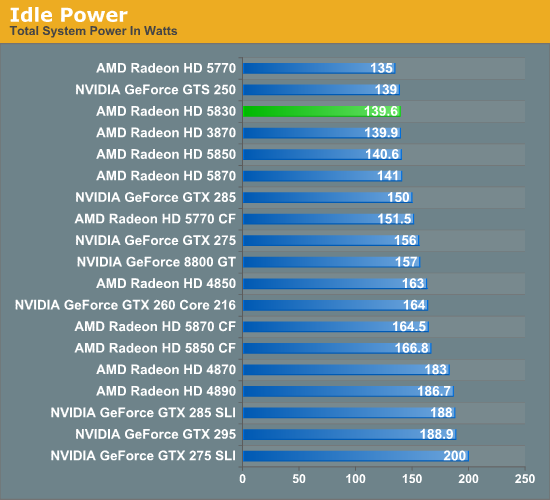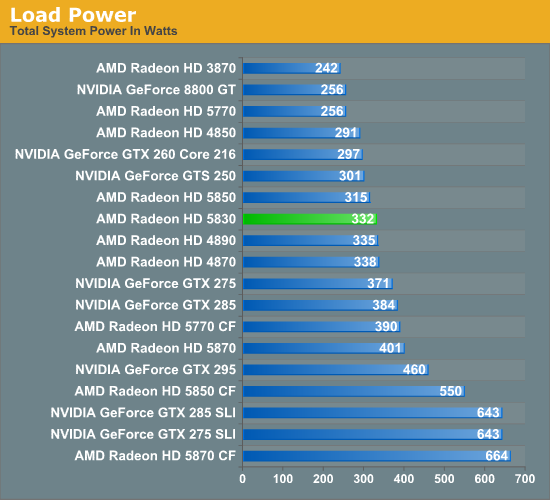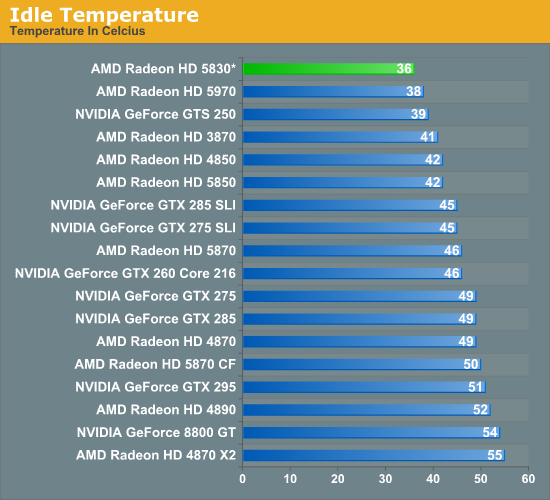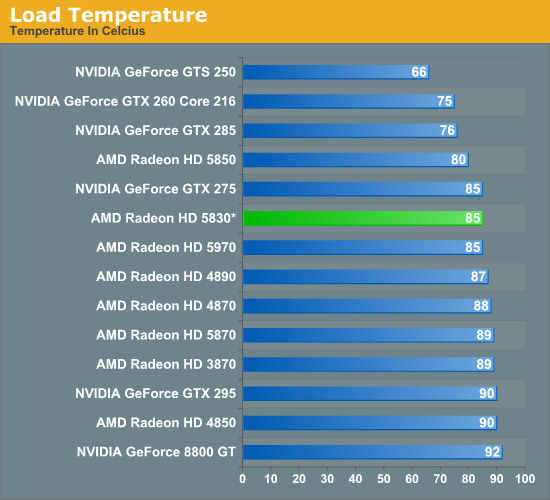AMD’s Radeon HD 5830: A Filler Card at the Wrong Price
by Ryan Smith on February 24, 2010 12:00 AM EST- Posted in
- GPUs
Power & Temperature
Since AMD isn’t doing a reference Radeon HD 5830, non-performance data is of limited value. Even with the variety of cards among AMD’s partners, the power draw of the 5830 cards should be within a few watts of each other and vary only with the difference in their fans so long as they use a 5870 PCB. On the other hand temperature data is going to heavily depend on the cooler used, and noise data is completely useless here since it entirely depends on the cooler used.
So we have power and temperature data for you, but please keep in mind that this temperature data is really only useful as a frame of reference – retail cards could be quite dissimilar.


At idle, the power usage is just as AMD promised: it’s a hair under the 5850, by a single watt to be exact. As far as high-end cards go, this is the least power hungry among them when idling.
Under load the story is quite a bit more interesting. We know the 5830 is rated for a TDP between the 5850 and 5870 that’s much closer to the 5870, but the power draw doesn’t reflect that. Here it’s 17W over the 5850, and nearly 70W off the 5870. We’ve double checked and the card isn’t throttling (a very possible situation given the higher voltage used) so we’re not quite sure what to make of these results. The 5830 is apparently more alike the 5850 than the 5870 when it comes to power consumption, which is certainly a good thing since it means it edges out the 4870 and 4890, and is well ahead of the GTX 275.


With an eye on the fact that this temperature data is going to be heavily dependent on the cooler used, for our sample card we certainly have some interesting results. Under idle this is the coolest of our high-end cards, which is no surprise given the use of the 5870’s big cooler and the lower idle power usage of the 5830. On the other hand under load, even with the otherwise minor difference in power draw compared to the 5850 and the bigger cooler it’s 5C hotter, which is actually more in-line with what we would have expected. However it still stays below the 4800 series and the 5870, both of which get warm enough that they really have to rev up their fans.
It’ll be interesting to see just how good the vendor coolers end up being. With the relatively low load power usage, the 5830 doesn’t have to be a particularly loud card.










148 Comments
View All Comments
7Enigma - Thursday, February 25, 2010 - link
Ryan,I really don't understand the results here. You have this new card with:
-more stream processors
-more texture units
-the same number of ROPS
-50 MHz slower core clock (that's 5% btw)
-virtually the same memory clock
-same bus width
-same frame buffer size
How the heck can it be 20% slower than the 4890? Can this really be due to driver issues. On paper I just can't see this being more than 5% slower in a game that is solely bottlenecked by the core clock, and in most cases would expect it to be faster than the 4890.
Is there something crazy like the 2.15B transistor count is causing the data to travel longer distances (or leakage issues) than the 4890 with its ~1B count? That doesn't jive with my brain but I'm not able to come up with any other reason why the 5830 should be slower....
Assimilator87 - Thursday, February 25, 2010 - link
Yeah, the most baffling fact from this review isn't how horribly priced the 5830 is, it's how a card with 40%, 40...percent, more shaders and texturing units and a newer architecture can be slower. It's absolutely mind boggling. I'd really love it if Ryan or Anand would do a reevaluation of the Evergreen architecture to gain some insight as to why it's so much less efficient than the R700 family.Paladin1211 - Thursday, February 25, 2010 - link
I think Ryan has stated it very clearly:"Moving away from the 5450 for a moment, besides the Radeon HD 5770 this is the only other card in the 5000-series that is directly similar to a 4000-series card. In fact it’s the most similar, being virtually identical to the 4550 in terms of functional units and memory speeds. With this card we can finally pin down something we couldn’t quite do with the 5770: clock-for-clock, the 5000-series is slower than the 4000-series.
This is especially evident on the 5450, where the 5450 has a 50MHz core speed advantage over the 4550, and yet with everything else being held equal it is still losing to the 4550 by upwards of 10%. This seems to the worst in shader-heavy games, which leads us to believe that actual cause is that the move from DX10.1 shader hardware on the 4000-series to DX11 shader hardware on the 5000 series. Or in other words, the shaders in particular seem to be what’s slower."
http://www.anandtech.com/video/showdoc.aspx?i=3734...">http://www.anandtech.com/video/showdoc.aspx?i=3734...
Ryan Smith - Thursday, February 25, 2010 - link
And at this point, that's still the best answer I can give you. I don't know exactly why this card is slower; it does well in synthetic benchmarks. A general degree of shader inefficiency still seems to be the most likely culprit.silverblue - Friday, February 26, 2010 - link
Perhaps AMD can shed some light on the subject, though I expect they'll more than likely wait for you to post a follow-up article before admitting anything. I refuse to believe it's bad drivers that aren't taking proper advantage of the hardware, a la the 8500.pierrebai - Thursday, February 25, 2010 - link
Ask for new benchmark using the lastest AMD drivers. Each release improves the perfs for the new cards. For example, for 10.2:DiRT 2 – Overall performance improves up to 8% on ATI Radeon™ HD 5970, ATI
Radeon™ HD 5800 series, and ATI Radeon™ HD 5700 series products
Battleforge – CrossFire ATI Radeon™ HD 5870 performance improves up to 6%
Unigine Heaven – DirectX 9 CrossFire performance has improved significantly on
ATI Radeon™ HD 5700 and ATI Radeon™ HD 5800 series products
The Chronicles of Riddick – Assault on Dark Athena – Overall performance on
ATI Radeon™ HD 5970 improves up to 4%
...
LordanSS - Thursday, February 25, 2010 - link
Latest drivers are buggy. No can do games with stupid mouse cursor issues and videos causing crashes.Until they definitely fix these issues, 9.12 hotfix it is.
silverblue - Thursday, February 25, 2010 - link
I think someone once said that they believed the 5xxx series to be slower, clock-for-clock, than the 4xxx series. Certainly seems to be ringing true in this case.coldpower27 - Thursday, February 25, 2010 - link
Agreed in theory the 5870 is double the 4890, you have the same core clock, 2x the SIMD's, 2x ROP's. 2x the Texture Units, but only a 23% increase in Memory Bandwidth. And on average your looking at 40-50% faster.The SIMD's on the 5xxx just aren't as powerful as the one's on the 4xxx Series.
I hope that is no the case on the Fermi core.
Xtrafresh - Thursday, February 25, 2010 - link
Good point. I can see all the extra feature hardware get in the way of straight-up performance as the only explanation i can come up with now.